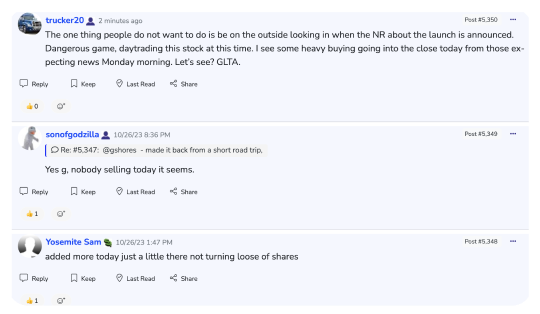READ BELOW TO SEE WHAT IS NEXT ANY DAY NOW.READ BOLD
Deficiency notice
If a company is in violation of the continued listing standards for a period of 30 consecutive days, the NASDAQ sends a "deficiency notice." The most common reasons for a deficiency notice are a share price that falls below $1.00 or a market cap that falls below the stated minimum (as low as $5 million if other requirements are satisfied).
Once a deficiency notice has been sent, the company has 90 days to comply with the continued listing standards, or 180 days if the violation was for a sub-$1.00 share price. In order to be compliant, the company's share price or market cap must rise above the minimum for at least 10 consecutive days in the 90-day (or 180-day) period.
Of course, becoming compliant for violating some of the other requirements is pretty straightforward. For example, if a company receives a deficiency notice for failing to pay its listing fee, the fix is obvious -- pay the fee.
If the company fails to comply
If the conditions that triggered the deficiency notice are not met in time, the NASDAQ will then send the company a delisting letter, which must be disclosed to the public within four business days.
There is an appeal procedure that a company can use, if it feels that it doesn't deserve to be delisted or if it can regain compliance in a reasonable amount of time. Once the company receives the delisting letter, it has seven days to request a hearing with the NASDAQ listing qualification panel to present its case, which postpones the delisting process until the panel makes a decision.
Unless an appeal is filed, the company's stock is halted, and then delisted after seven days. If the appeal is rejected, the company also has the option to appeal to the SEC or in federal court. The NASDAQ gives the company an additional 15 days to do so, but begins its final delisting procedures during that time.
What happens after a company is delisted?
Keep in mind that the delisting of a company doesn't mean that the stock can't continue to trade. Delisted companies can choose to be listed on the over-the-counter (OTC) markets or on the pink sheets. There are some negative implications resulting from delisting, such as a loss of investor confidence, and potentially reduced access to capital, but it's not necessarily a death sentence. Companies can (and have) return to compliance and relist on the NASDAQ after delisting.
Recent JAGX News
- Form 8-K - Current report • Edgar (US Regulatory) • 03/08/2024 10:00:33 PM
- Form PRE 14A - Other preliminary proxy statements • Edgar (US Regulatory) • 03/05/2024 12:00:14 PM
- Form 8-K - Current report • Edgar (US Regulatory) • 03/01/2024 10:30:56 PM
- Form 8-K - Current report • Edgar (US Regulatory) • 02/16/2024 09:13:11 PM
- Form 8-K - Current report • Edgar (US Regulatory) • 12/01/2023 10:25:44 PM
- Form D - Notice of Exempt Offering of Securities • Edgar (US Regulatory) • 11/30/2023 01:10:26 PM
- FILAMENT HEALTH ANNOUNCES THIRD QUARTER 2023 FINANCIAL RESULTS AND OPERATIONAL HIGHLIGHTS • PR Newswire (Canada) • 11/15/2023 02:00:00 AM
- Form 8-K - Current report • Edgar (US Regulatory) • 11/08/2023 10:03:21 PM
- Form 8-K - Current report • Edgar (US Regulatory) • 10/05/2023 09:03:29 PM
- FILAMENT HEALTH AND JAGUAR HEALTH JOINT VENTURE MAGDALENA BIOSCIENCES COMPLETES IMPORT OF COCA LEAF FROM PERU • PR Newswire (Canada) • 09/21/2023 11:30:00 AM
- Form 4 - Statement of changes in beneficial ownership of securities • Edgar (US Regulatory) • 08/14/2023 08:55:07 PM
- Form 4 - Statement of changes in beneficial ownership of securities • Edgar (US Regulatory) • 08/14/2023 08:53:36 PM
- Form 4 - Statement of changes in beneficial ownership of securities • Edgar (US Regulatory) • 08/14/2023 08:50:14 PM
- Form 4 - Statement of changes in beneficial ownership of securities • Edgar (US Regulatory) • 08/14/2023 08:49:16 PM
- Form 4 - Statement of changes in beneficial ownership of securities • Edgar (US Regulatory) • 08/14/2023 08:48:05 PM
- Form 4 - Statement of changes in beneficial ownership of securities • Edgar (US Regulatory) • 08/14/2023 08:46:36 PM
- Form S-8 - Securities to be offered to employees in employee benefit plans • Edgar (US Regulatory) • 08/14/2023 08:16:51 PM
- Form 8-K - Current report • Edgar (US Regulatory) • 08/14/2023 01:05:08 PM
- Form 8-K - Current report • Edgar (US Regulatory) • 07/07/2023 09:27:33 PM
- Form 8-K - Current report • Edgar (US Regulatory) • 07/03/2023 09:00:36 PM
Axis Technologies Group and Carbonis Forge Ahead with New Digital Carbon Credit Technology • AXTG • Apr 24, 2024 3:00 AM
North Bay Resources Announces Successful Equipment Test at Bishop Gold Mill, Inyo County, California • NBRI • Apr 23, 2024 9:41 AM
Epazz, Inc.: CryObo, Inc. solar Bitcoin operations will issue tokens • EPAZ • Apr 23, 2024 9:20 AM
Avant Technologies Launches Advanced AI Supercomputing Network and Expansive Data Solutions • AVAI • Apr 23, 2024 8:00 AM
BestGrowthStocks.com Issues Comprehensive Analysis of Triller Merger with AGBA Group Holding Limited • AGBA • Apr 22, 2024 1:00 PM
Cannabix Technologies to Present Marijuana Breathalyzer Technology at International Association for Chemical Testing (IACT) Conference in California • BLO • Apr 22, 2024 8:49 AM










